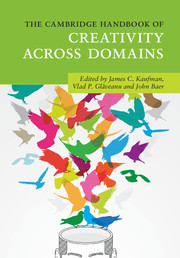Book contents
- The Cambridge Handbook of Creativity Across Domains
- The Cambridge Handbook of Creativity Across Domains
- Copyright page
- Dedication
- Contents
- Figures
- Tables
- Contributors
- Acknowledgments
- Part I Creativity and Domain
- Part II Creativity in the Traditional Arts
- Part III Creativity in the Sciences
- Part IV Creativity in Business
- Part V Newer Domains for Creativity Research
- Part VI Creativity in Everyday Life
- Part VII Conclusion
- Index
- References
Part VI - Creativity in Everyday Life
Published online by Cambridge University Press: 15 September 2017
- The Cambridge Handbook of Creativity Across Domains
- The Cambridge Handbook of Creativity Across Domains
- Copyright page
- Dedication
- Contents
- Figures
- Tables
- Contributors
- Acknowledgments
- Part I Creativity and Domain
- Part II Creativity in the Traditional Arts
- Part III Creativity in the Sciences
- Part IV Creativity in Business
- Part V Newer Domains for Creativity Research
- Part VI Creativity in Everyday Life
- Part VII Conclusion
- Index
- References
Summary
The role of emotions in the creative process is well documented. In this chapter, we distinguish emotional processes in creativity from creativity in the domain of emotions. Creativity in the domain of emotions exists when people are creative with emotions – emotions are the object of the creative process. We describe three kinds of creativity in the domain of emotions – emotional creativity (experience of unique emotions), creative communication of emotions, and creative emotion regulation. Furthermore, we present a model in which we argue that creativity in the domain of emotions is less likely to have the same impact on society and culture as creativity in other domains that are more defined by education and formal gate keepers (e.g., art or science), but that it is crucial for psychological health and well-being.
- Type
- Chapter
- Information
- The Cambridge Handbook of Creativity across Domains , pp. 523 - 632Publisher: Cambridge University PressPrint publication year: 2017



